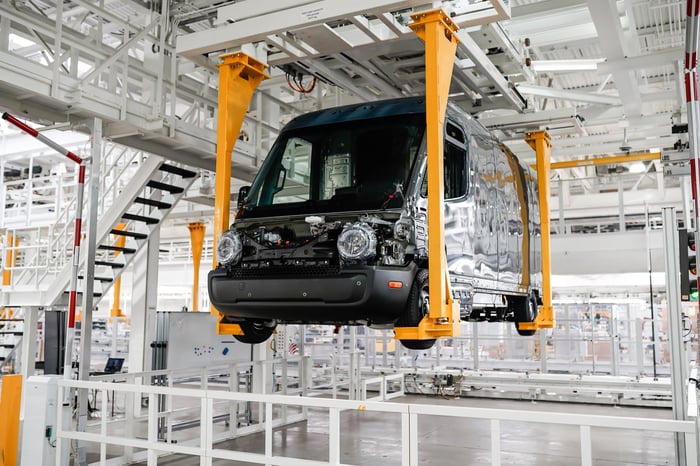Back in May 1997, a company that would forever change the way we shop was listed on the Nasdaq stock exchange. It gave investors an opportunity to buy a slice of the future -- though many of them didn't know it at the time.
Fast forward 25 years, and the company just reported over half a trillion dollars in annual revenue for 2022. It was Amazon (AMZN -1.14%), of course, the widely recognized pioneer of the e-commerce industry.
Its success is thanks to a relentless focus on innovation. Amazon's business is no longer about e-commerce alone; it has become a leader in the cloud computing industry, has a booming advertising business, and has a growing portfolio of digital media assets.
But like all good innovators, sometimes Amazon misses the mark. The company made a bet on shares of electric vehicle maker Rivian Automotive (RIVN 1.03%) back in 2019, and while the partnership is bearing fruit in some ways, it was a major drag on Amazon's earnings during 2022. Let's explore the details.
Amazon's e-commerce business took a breather in 2022
Inflation hit a 40-year high in June 2022, which prompted the U.S. Federal Reserve to embark on the most aggressive campaign to hike interest rates in history. It's not surprising, then, that consumers abruptly pulled back on their spending habits, which directly impacted Amazon's revenue.
While Amazon's e-commerce business generated a mammoth $220 billion in online sales during 2022, that figure was down 1% compared to 2021. Investors are understandably nervous that the largest piece of its business failed to deliver growth, which is a key reason why Amazon stock is currently down 45% from its all-time high.
But the company continued to innovate throughout the year regardless. It expanded its same-day delivery program to Belgium and also sped it up in some metropolitan cities. Plus, it made its Buy with Prime program available to more merchants who can now offer customers free delivery, and reduced friction in the checkout process, which is proven to increase conversions by 25%. These moves prepare Amazon to make more sales once consumer spending picks up again.
Amazon's cloud and advertising businesses stood out
Amazon Web Services (AWS) is the segment of Amazon's business that many investors watch the closest. Why? Because it routinely out-grows the rest of the company, and it comes with a very high profit margin. It generated $22.8 billion in operating income during 2022, which offset the operating loss made by the rest of Amazon as a whole.
AWS revenue jumped by 28.7% in 2022 compared to 2021, compared to 9% for the entirety of Amazon's business. That outperformance means AWS is quickly becoming a larger part of the overall pie. The cloud segment now represents an all-time high 15% of Amazon's companywide revenue.

This trend could continue for years to come as more organizations invest in their digital transformations. AWS offers the broadest range of cloud products and solutions whether customers need simple data storage or advanced artificial intelligence tools. An estimate by Grand View Research pegs the opportunity at $1.5 trillion by 2030.
But there's another piece of Amazon's business catching the eye of investors: advertising. The amazon.com website attracts roughly 2.5 billion visits per month, so it's an ideal place for sellers to market their goods.
But the company has also built an impressive portfolio of media assets across the entertainment spectrum, with a special nod to its investments in live sports rights. It exclusively airs the NFL's Thursday Night Football, which broke records in 2022 with four games making it into Variety's Top 100 Primetime Telecasts. Amazon became the first streamer to ever make the list.
Such assets are incredibly attractive to advertisers and will help the company continue growing its ad business, which generated a whopping $37.7 billion in revenue during 2022. That was up 21% compared to 2021.
How Rivian sank an entire year's worth of Amazon's earnings

Image source: Rivian Automotive.
Like many large organizations across America, Amazon is conscious of its environmental footprint given the scale of its operations. As a result, in 2019 it signed a deal with Rivian Automotive to purchase 100,000 electric delivery vans by 2030.
The first vans hit the road in 2022, and in the fourth quarter delivered their 10 millionth package for Amazon.
But this relationship runs much deeper. When Amazon placed its order, it also led a $700 million funding round for Rivian to help the company accelerate its progress. Prior to Rivian's initial public offering in 2021, the e-commerce giant revealed it owned 20% of the automaker's shares.
Unfortunately, Rivian stock has been in decline ever since. It plunged 82% in 2022, dealing Amazon a paper loss of $12.7 billion, wiping out the entirety of the company's $12.2 billion in operating income for the year.
The significance of that cannot be overlooked because it resulted in Amazon delivering its first annual net loss since 2014.
But here's the good news: The fluctuations in Rivian stock over time largely won't affect what Amazon is doing across the rest of its business. Investors should continue to focus on the cloud and advertising segments in 2023, and especially the e-commerce segment, which could see a return to growth as the economy improves.
Looking back to this time in a few years from now, the current 45% dip in Amazon stock might've been a fantastic buying opportunity.





